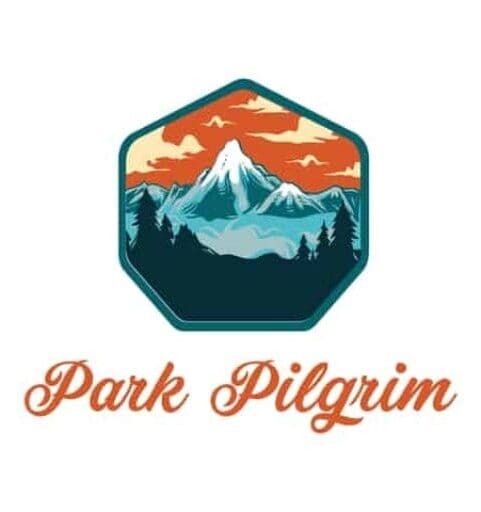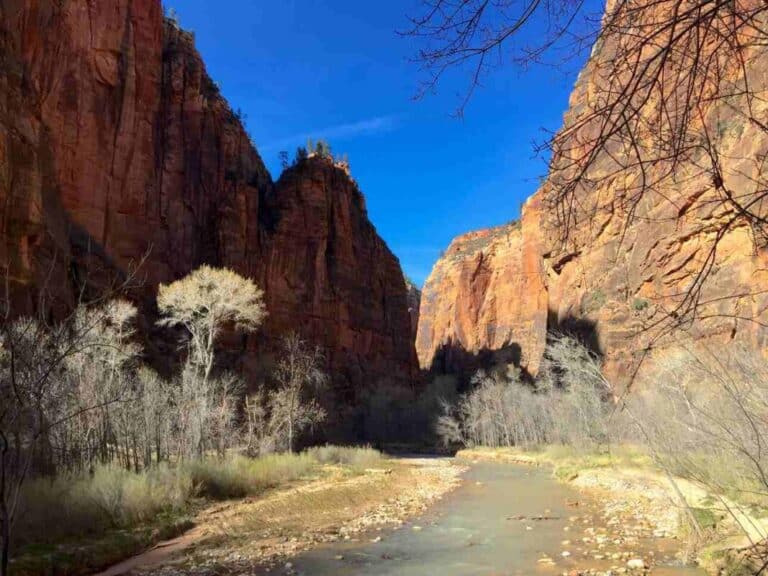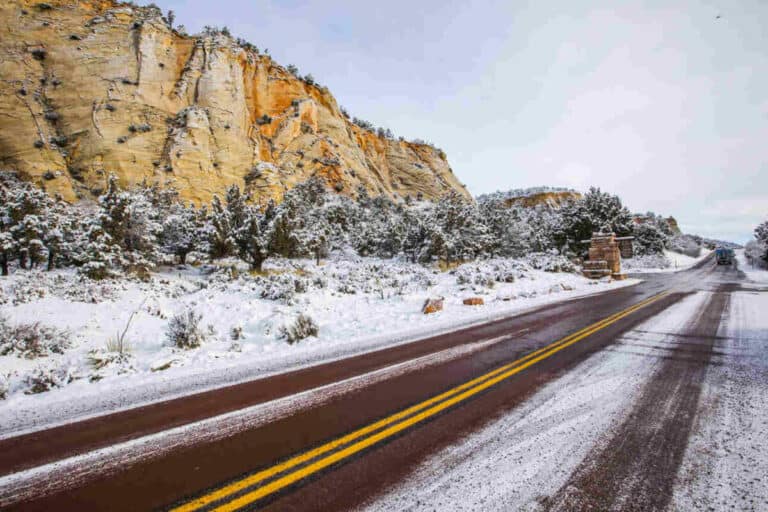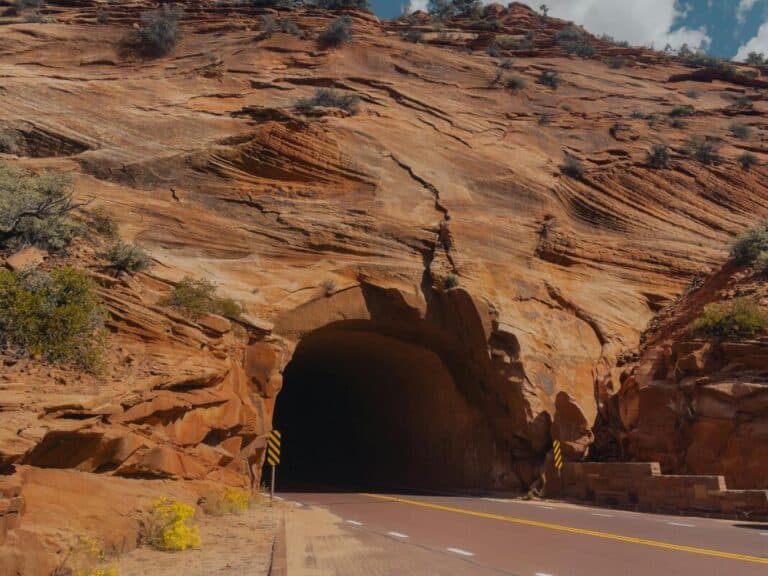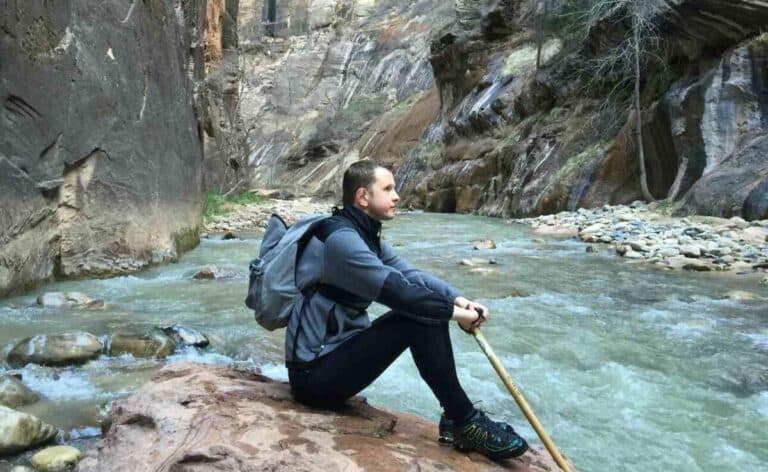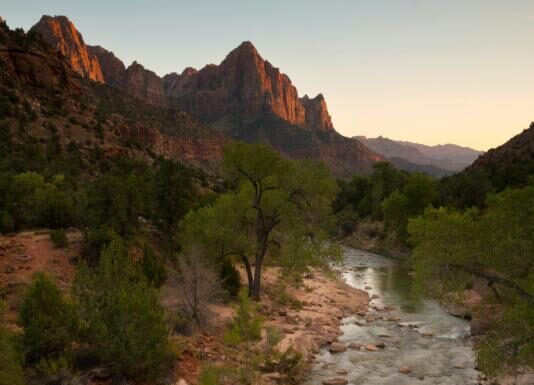Biking in Zion National Park: Routes, Riding Tips and Safety
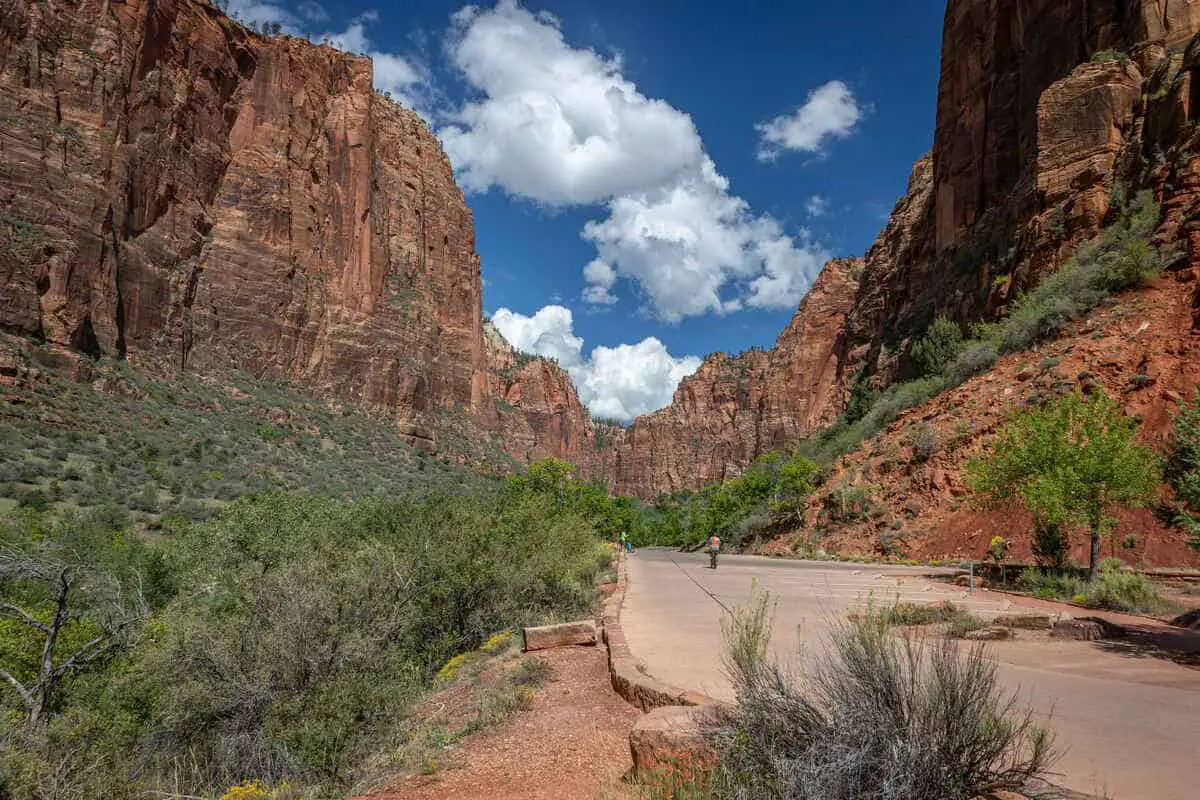
Sure, you can drive through Zion National Park by car or RV, do lots of great hiking and have the time of your life. But there’s another way to explore the park that’s often overlooked and soooo worth it: by bike! In this post, I’ll tell you everything you need to know to make your cycling trip through Zion rewarding, easy and safe.
This post contains affiliate links, and any sale made through such links will reward this site with a small commission – at no extra cost to you.
Just imagine the refreshing breeze that caresses your body while zipping through scorching hot Zion. You’re not going too fast, but you’re going way faster than walking.
You can quickly stop anywhere and take some Insta-magic to avoid forgetting your adventures in the Red Rock Refuge. Biking in Zion is fun and, if you ask me, an absolute must-do during your visit to the park.
Nuff said. Let’s dive in!
Why Cycling in Zion National Park Is Worth It
If you’re unsure if this is an activity you want to do during your visit to Zion, let me give you four good reasons to take a bike ride in the park. Here they are:
1. It’s Fun
Cycling in Zion National Park is undeniably a fun experience. Bicycles are allowed in specific park areas, which means opportunity galore for an exciting adventure. Riding the scenic routes while breathing in the fresh air will surely bring a smile to your face.
2. It’s Arguably the Best Way to See the Park
Cycling is probably the best way to take in Zion’s beauty. You can truly appreciate the stunning views and immerse yourself in the park’s atmosphere by pedaling at your own pace.
With shuttle tickets required from March through the fall (when you can’t enter Zion Canyon Scenic Drive by car), cycling allows you to enjoy the park without the crowds. But don’t take my word on it. Try it yourself to find out!
3. It’s Good Exercise
Cycling is a fantastic way to work out while exploring Zion National Park. Combining inclines, declines, and flat surfaces adds variation. Moreover, the natural beauty of the park and the fresh air can easily motivate you to keep going.
4. It’s Suitable for all Fitness Levels
Zion offers biking opportunities for all fitness levels, from leisurely rides to more challenging routes. The Pa’rus Trail is an easy and nearly flat route for families or casual cyclists and suitable for all bike types.
At the same time, if you’re seeking a challenging ride, you can tackle Kolob Terrace Road. The ride climbs around 5,000 feet (1,524 meters) and covers 25 miles (40 kilometers).
The park’s variety of trails ensures that you can always find a path suitable for your skill level and comfort.
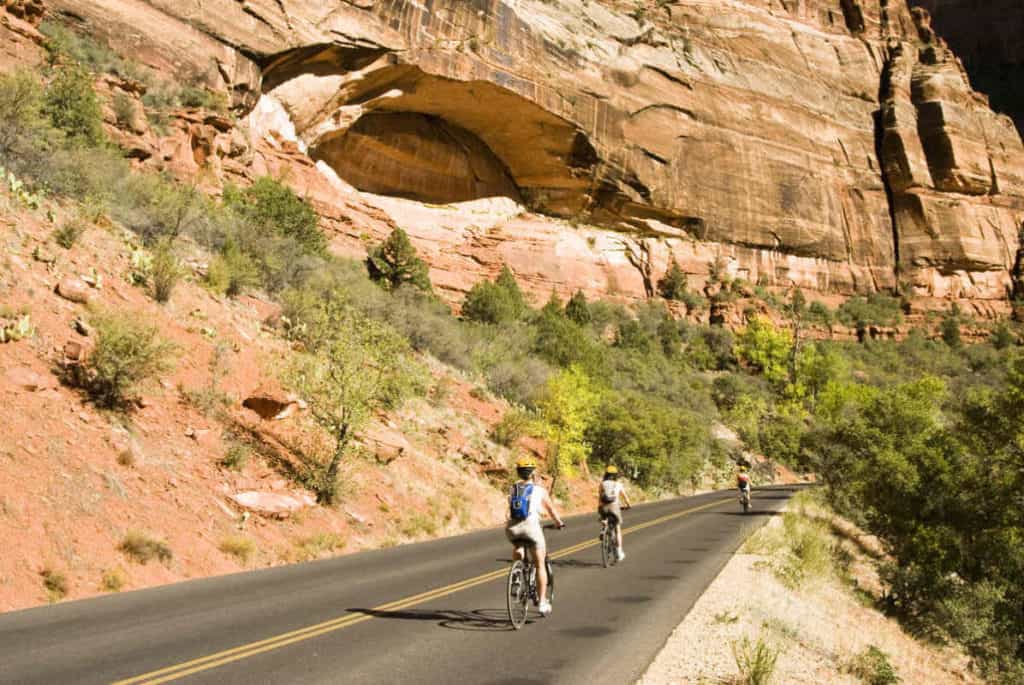
Is Biking in Zion National Park Safe?
Biking in Zion National Park is generally considered safe if you follow the park’s rules and guidelines. Cyclists are permitted on all park roadways and on the Pa’rus Trail, a paved trail also open to pedestrians.
However, all other park trails, off-trail routes, and the Zion-Mount Carmel Tunnel are closed to bikes.
Wear a helmet and ride single file on the right side of the park roads and the Pa’rus Trail. In Zion, cyclists are limited to groups of six bikes or less.
What About Biking with Kids?
There are some family-friendly options if you plan to bike with kids in Zion National Park. The Pa’rus Trail is a popular choice for families, as it is an easy, paved trail that follows the Virgin River and offers stunning views of the surrounding canyon walls.
The trail is relatively flat and open to cyclists of all skill levels, making it enjoyable for both parents and children. Regarding safety, the Pa’rus Trail is not accessible for cars or other motorized vehicles.
Another option for biking with kids is to embark on a guided family bike tour. These tours typically cater to riders of varying abilities and age groups. A guide will lead you along suitable routes, considering the safety and enjoyment of you and your family members. Sounds good, right?
When biking with kids in Zion National Park, ensure that your kid is properly equipped with a helmet and the correct size bike.
Is Biking in Zion National Park Hard?
Biking in Zion National Park can be challenging, depending on your experience and fitness level. Ultimately, it’s up to you what kind of challenge you’re looking for.
There are routes with almost flat terrain, as well as climbs and rocks. Read below to learn about the most popular routes and what they involve. It will help you decide which ones are for you and which ones aren’t.
When to Bike in Zion?
Knowing the best time for a biking trip in Zion National Park can significantly improve your experience. So you should know that the most crowded time in Zion is between March and October. That’s why booking your shuttle tickets in advance is wise if you visit during that time, although it’s not mandatory.
However, if you visit in winter, you have the advantage of being able to drive your own car into the canyon, which can be a more flexible option. Especially if you want to take your own bike and park your vehicle where you want to start your cycling trip.
It’s probably wise to follow safety rules and guidelines while biking in the park. Which means: Staying on designated routes and always wearing a helmet.
What Is the Zion Entrance Fee for Bikes?
Before you pedal away, you should know that Zion National Park has an entrance fee. This fee applies to all visitors to the park, including cyclists.
If you’re entering the park with a bike, your entrance fee will depend on the type of pass you choose. You can purchase a Zion week pass ($20) or an annual interagency pass ($80). There are other options, but these two will work for most people.
You must pay the vehicle fee ($35 or $80) if you enter the park with your bike mounted on your car’s bike carrier.
You can pay with a credit or debit card and cash on the spot.
Top Biking Trails
There are several popular biking routes in Zion National Park. I’ve listed the most popular trails and climbs below.
Pa’rus Trail
The Pa’rus Trail is popular among bikers for its paved and relatively flat terrain. This scenic trail starts at the park entrance and follows the Virgin River, providing picturesque views of the surrounding landscapes. You may have to share it with pedestrians and people in wheelchairs.
This trail is a perfect way to enjoy the park’s beautiful scenery without much difficulty.
Zion Canyon Round-Trip
Looking for a longer ride? Take a round trip along the Zion Canyon Scenic Drive. At about 15.5 miles (25 kilometers), this out-and-back ride offers plenty of breathtaking canyon scenery. You’ll ride on a paved road.
However, this route is moderately challenging due to its length and elevation changes. An excellent way to test your endurance and strength.
Zion Canyon One-Way
If you prefer a shorter experience, a Zion Canyon one-way ride might be just what you need. Hop on the park shuttle with your bike and ride it to the last shuttle stop at the Temple of Sinawava. From there, you can enjoy a 7.7-mile (11-kilometer) ride back to the park entrance.
Mt. Carmel Tunnel Climb
If you are interested in a hill climb, you might want to tackle the Mt. Carmel Tunnel Climb on Highway 9, east of Zion Canyon Drive. This climb gains 900 feet (274 meters) in just over three miles (4.82 kilometers), making it the best road bike hill climb in Zion. It’s an excellent leg workout, and you’ll never be short of breathtaking views.
Be aware that you’ll need to turn around when you reach the Mt. Carmel Tunnel, which is only accessible by motorized vehicles. The road leading to the tunnel is exposed in places, although it is wide enough to keep a safe distance from other traffic.
Other Routes
There are other biking routes, such as the E Kolob Canyon Road in the northwestern part of the park. It takes you along the stunning Kolob Fingers Scenic Road Scenic Byway (10 miles or 16 kilometers round trip). However, it’s not connected to Zion Canyon.
Nearby Trails (Mountain Biking)
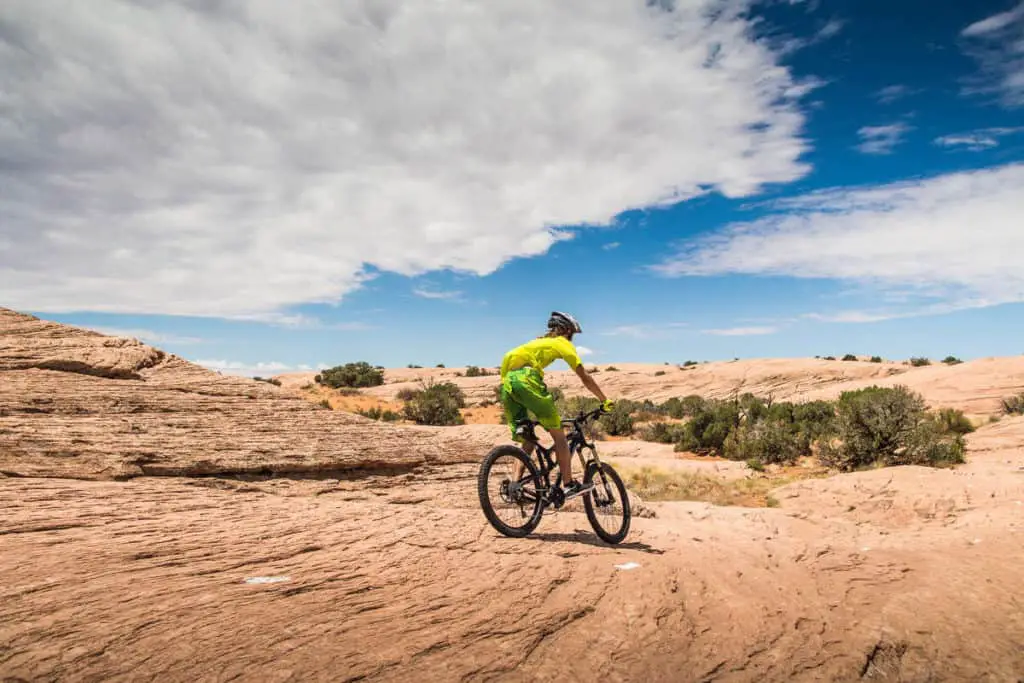
For mountain bikers seeking a challenge, several trail systems near Zion National Park offer various difficulty levels and terrain.
Gooseberry Mesa
Gooseberry Mesa is a well-known trail system that boasts a mixture of slick rock and singletrack. This 20-mile (32 kilometers) route takes you to 5,200 feet (1,585 meters) altitude. It offers spectacular views of the surrounding desert mesas and canyons, perfect for adding thrill to your adventure if you ask me.
JEM Trail
The JEM Trail is another nearby option that provides fast, flowy singletrack with fun descents and eye-catching scenery. It’s a fantastic ride for experienced bikers looking for a rush.
Bunker Creek Trail (Right Fork)
For a more remote and diverse experience, the Right Fork: Bunker Creek Trail offers a unique combination of fast singletrack, silky smooth forest floor, and rocky sections. This trail is almost all downhill. In the last five miles, you will encounter a transition from singletrack to doubletrack to pavement.
Take Your Bike on the Park Shuttle
Taking your bike on the park shuttle is convenient for exploring Zion National Park. Bicycles are allowed on the park shuttle buses, but you need to be able to lift the bikes on and off the front racks yourself.
When planning your trip, know that shuttle tickets are required for entering Zion Canyon (the most popular portion of the park) from March through the fall. If you’re visiting in winter, you can drive your vehicle (with a bike rack) into the canyon.
Biking Rules in Zion
You need to stick to specific rules when biking in Zion National Park. One of the main aspects is that bicycling is allowed on all park roadways and the Pa’rus Trail. However, biking is prohibited on other park trails, off-trail routes, and the Zion-Mount Carmel Tunnel.
While cycling, ride single file on the right side of park roads and the Pa’rus Trail. Always wear a helmet, as park regulations require it. Cyclist groups are limited to six bikes or fewer to prevent creating traffic jams on trails or roadways. So you’d have to divide into smaller groups and space out your rides if your group is larger.
When encountering shuttle buses, be prepared to yield to them. Seek a safe place to pull over when a shuttle bus approaches and let it pass. Never attempt to pass a moving bus.
In case you’re wondering, E-bikes and regular bikes share the same regulations, but e-bikes are permitted on the Pa’rus Trail and all park roadways.
What to Wear When Biking in Zion
When biking in Zion National Park, make sure you dress appropriately for the weather and trail conditions. Comfortable, breathable clothing will help you enjoy your ride and avoid discomfort.
Probably the most important piece of garment: Start with a comfortable pair of cycling shorts or pants.
They will provide comfort during long rides and offer padding to reduce potential soreness. Combine this with a moisture-wicking shirt that will keep you dry in warmer temperatures and add layers in cooler weather.
Don’t forget to bring a lightweight rain jacket, as the weather can be unpredictable, especially in the shoulder seasons.
And there’s the footwear as well. Opt for closed-toe shoes with a good grip, such as cycling shoes or sneakers with a sturdy sole. This will help you maintain control of your bike and feel confident when you need to walk.
Also, don’t forget to protect your head by wearing a helmet while biking in Zion National Park.
Furthermore, wear sunglasses with UV protection to shield your eyes from the sun and reduce glare. This will help you see the trail more clearly and avoid potential hazards.
Additionally, wearing a hat under your helmet can provide extra sun protection.
Lastly, pack a lightweight jacket or windbreaker, as the weather in Zion National Park can change rapidly. This layer can be easily stored in your backpack when not in use, ensuring you’re prepared for sudden changes in temperature or rain.
Essential Gear for Biking in Zion
Packing the right items before heading out on your biking adventure in Zion National Park will help make your ride smoother, safer, and more enjoyable. So, let’s have a look at what gear we’re looking at here.
- Bring a basic first-aid kit with band-aids, antiseptic wipes, and pain relief medication. You never know when minor injuries might occur.
- Having adequate hydration is essential for any outdoor activity. So, bring a water bottle or hydration pack to stay well-hydrated throughout your ride. You might also consider packing some energy snacks like granola bars or trail mix to keep your energy levels up during your ride.
- Also, having the necessary tools and equipment for essential bike maintenance and repairs is important. A multi-tool with Allen keys, a tire lever, and a patch kit can help you handle minor repairs or adjustments on the go.
- Additionally, add a spare tire tube and a compact pump or CO2 cartridge to your gear list. A flat tire can happen anytime.
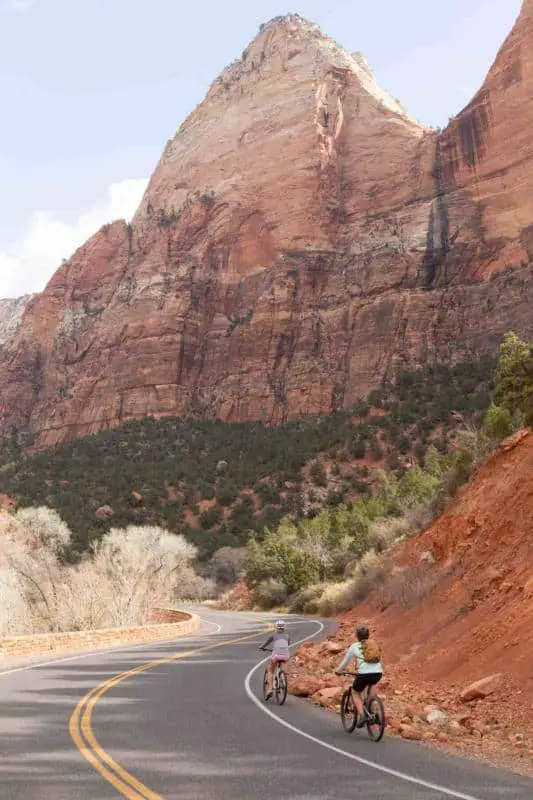
Bike Rentals and Repairs in Zion
You probably didn’t bring your own bike for your visit to Zion National Park. Not to worry. There are several bike rentals in and near the park.
Below, I also included a section on the pros and cons of the different types of bikes you can rent.
And in case you did bring your own bike and need to have it fixed, I also included the repair services in the area.
What Types of Bikes Can You Rent in Zion?
Some of the popular types of bikes that you can rent in Zion include:
- Regular Pedal Bikes: These traditional, non-electric bikes are perfect for casual rides along the scenic trails in Zion. You can find these at Zion Cycles;
- E-bikes: Electric bikes provide extra power when needed, making them ideal for extended rides or tackling more challenging terrain. Zion Peddler offers e-bike rentals with large battery capacities;
- Gravel Bikes: Gravel bikes are designed for a mix of pavement and off-road riding, making them a versatile option for exploring the various trails in Zion. Check out the available options at Zion Cycles;
- Road bikes are primarily for experienced riders who enjoy riding at a faster pace. Zion Cycles has several options for you;
- Full-Suspension Mountain Bikes: These bikes are designed for off-road biking and navigating more demanding trails, such as those found on Gooseberry Mesa. Zion Cycles also provides full-suspension mountain bike rentals.
Many providers offer additional services such as helmet rental and bike locks. Some even include holders for walking sticks if you plan on exploring trails like the Narrows. Be sure to check the available options when booking your rental.
If you want to rent an e-bike, you can easily do so online by clicking the link.
Pros and Cons of Bike Types
Maybe you’re not picky about the kind of bike to rent or don’t know what bike best suits your intended trip. To help make your decision easier, I put the pros and cons of the different types of bikes below.
Regular Pedal Bikes
PROS
- Most regular pedal bicycles are lightweight and easy to maneuver, which can be advantageous for navigating traffic;
- Regular pedal bikes are highly efficient in energy use, with a high percentage of the rider’s energy converted into forward motion.
CONS
- While it’s a pro for some, the physical effort required for riding a regular pedal bike can be a con for those with mobility issues or who prefer less strenuous transportation;
- Regular pedal bikes may struggle on rough terrain or steep hills, limiting their usability in some park areas;
- Climbing steep hills can be physically demanding on a regular pedal bike, especially if you have a lower fitness level.
E-Bikes
PROS
- E-bikes provide electric assistance to the rider, making cycling more straightforward and accessible for people of all fitness levels;
- E-bikes provide a low-impact form of exercise that people of all ages and fitness levels can enjoy.
CONS
- E-bikes are more expensive than traditional bicycles, especially if you want a high-end model with advanced features. This makes their rental price higher than that of other bikes;
- E-bikes are often heavier than traditional bicycles, making them more challenging to transport, maneuver or store;
- E-bikes require regular charging and maintenance, which can be an added inconvenience if the battery dies during a trip.
Gravel Bikes
Pros:
- Gravel bikes are designed to handle a variety of terrains, including gravel roads, pavement, dirt trails, and more. This versatility makes them suitable for a wide range of riding styles;
- Gravel bikes typically have a more relaxed and upright riding position than road bikes, which enhances comfort during long rides;
- Gravel bikes can accommodate wider tires with more tread, providing better traction and stability on rough and uneven surfaces;
- Gravel bikes’ longer wheelbase and slack geometry contribute to stability, mainly when riding on gravel or off-road terrain;
- Gravel bikes often come equipped with multiple mounting points for racks, fenders, and accessories, allowing riders to carry gear for bike packing or touring;
- Most gravel bikes are equipped with disc brakes, which offer reliable stopping power and perform well in wet or muddy conditions.
Cons:
- Gravel bikes are often heavier due to their robust construction and wider tires, which can affect speed and acceleration on smooth pavement;
- The more upright riding position and wider gravel bike tires make them less aerodynamic than traditional road bikes, reducing efficiency at high speeds;
- Gravel bikes may not be as fast on smooth pavement as dedicated road bikes, making them less suitable for competitive road racing;
- Gravel bikes typically lack suspension systems, so they may provide a less cushioned ride on extremely rough off-road terrain than mountain bikes.
Road Bikes
PROS
- Road bikes are designed for speed and efficiency, making them an excellent choice for racing or long-distance rides;
- Road bikes are typically lighter than mountain bikes, which makes them easier to ride and more efficient on smooth surfaces;
- The streamlined road bike design, including the drop handlebars and thin tires, helps reduce wind resistance and improve rider aerodynamics;
- Road bikes are generally easier to ride than mountain bikes, especially for inexperienced riders or if you’re in poor physical condition.
CONS
- Road bikes can be less comfortable than mountain bikes, as they do not have a suspension system to absorb shock;
- Road bikes are not built to withstand rough terrain and may be less durable than mountain bikes;
- Road bikes are less versatile as mountain bikes, as they are not well-suited for off-road cycling or rough terrain;
- A road bike’s thin tires and lack of suspension system may make it less stable and unable to handle rough or uneven surfaces.
Full-Suspension Mountain Bikes
PROS
- Full-suspension Mountain bikes are built to withstand rough terrain, making them durable for off-road cycling;
- Mountain bikes can be used for various cycling activities, including cross-country riding and downhill racing;
- A mountain bike’s wider tires and suspension system increase control and stability on rough terrain;
- Low-impact sport (less stress on your joints than activities like running). Some mountain bikes come equipped with padded seats and suspension systems that help to absorb shock and improve rider comfort.
CONS
- Mountain bikes are heavier than road bikes, making them less efficient for long-distance rides or smooth surfaces;
- Mountain bikes can be more expensive than road bikes, especially if you want a high-end model with advanced features;
- The wider tires and suspension system on a mountain bike can also make them less efficient on smooth surfaces, as they create more rolling resistance;
- Mountain biking can be more challenging than road biking, especially for inexperienced riders or those not in good physical shape. Overall, it’s important to consider the type of terrain you will be riding on before deciding whether a mountain bike is a suitable choice for you.
Bike Repairs in Zion
As for bike repairs, Zion Cycles has full-time technicians to address any issues with your bike during your trip.
Zion Cycles
Address: 868 Zion Park Blvd, Springdale, UT
Website: zioncycles.com
E-mail: Info@zioncycles.com
Phone: +1 (435) – 772 0400
Biking Tours in Zion
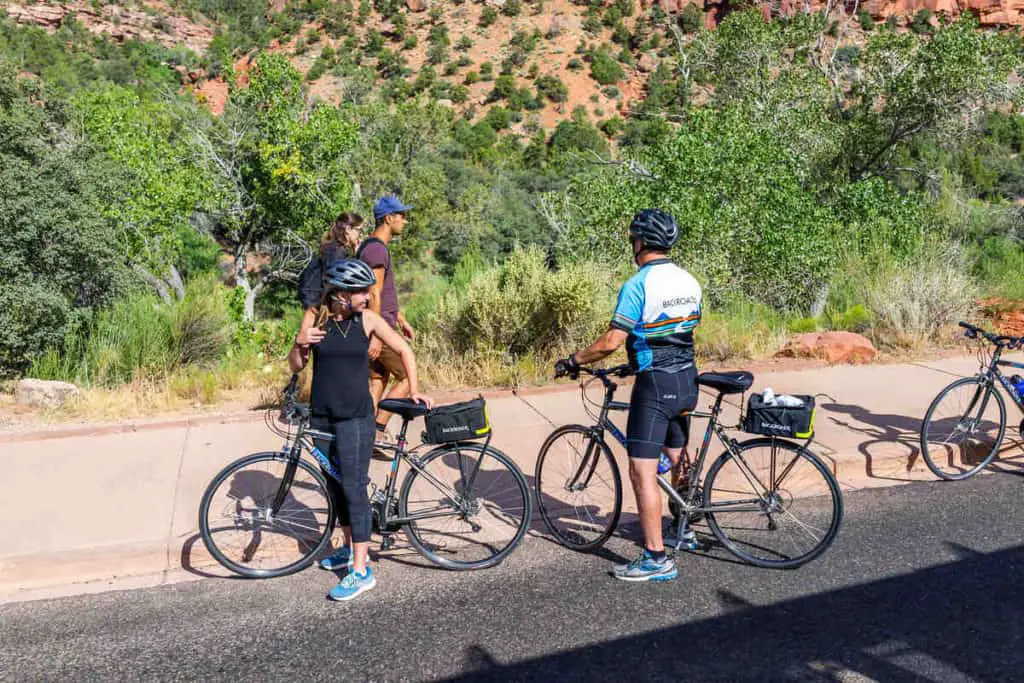
Zion National Park offers a variety of guided Zion National Park bike tours. These tours often combine biking and hiking, taking you through Zion’s canyons and mesas.
Here are three attractive Zion bike tour options:
Click a link to check the latest price.
Health and Safety Tips for Biking in Zion
Here are some things to consider regarding your health and safety during your bike ride in Zion National Park.
- Before setting off on your adventure, ensure your bike is working well. Check the brakes, tires, and gears to prevent any issues during your ride. Packing a puncture repair kit and a pump is also a good idea, as you’ll be riding on various terrains. The possibility of a puncture is real;
- Be prepared to stop and yield to others when necessary. As you ride through Zion National Park, be cautious on uphill and downhill sections, always maintaining control of your bike;
- Hydration is key, especially in hot weather or when tackling a challenging route. Carry plenty of water and remember to drink every 15-20 minutes to avoid dehydration. Bring energy-rich snacks, such as granola bars or trail mix, to keep your energy levels up during your ride;
- Check the weather forecast before heading out. Rain, extreme heat, or high winds can create challenging or dangerous conditions for cyclists.
Getting to Zion National Park
Getting to Zion National Park doesn’t have to be complicated. Depending on where you’re coming from, you have a few options. The most obvious is following Highway 9 to Springdale in the southeastern part of the park.
Another option is to take exit 40 on Interstate 15 Highway to E Kolob Canyon Road, leading you to Kolob Canyon. You’ll need to bring your bike, as there are no bike rentals in this park area. You must purchase your entrance fee at the Visitor Center, right after the exit on your right-hand side. You pay for a $35 park entrance pass, valid for a week.
If you don’t want to drive into the park (you can’t from March through late fall anyway, and you’ll have to take a shuttle), there’s an alternative. You can park your vehicle in Springdale or the Visitor Center before entering the park.
Entering the Park by Bike
If you want to enter the park on your bike, you must enter through the pedestrian entrance, as bicycles are not allowed through the drive-in door.
From there, you can walk across a footbridge and purchase a mandatory $20 entrance pass at the National Park ticket kiosk.
Accommodation Options near Zion
If you’re planning a bike trip to Zion National Park, finding a comfortable and convenient place to stay is probably a good idea. Several lodging options near the park cater to different budgets and preferences.
Cable Mountain Lodge is an excellent choice if you prioritize overall value. This hotel provides a sweet balance between comfort and proximity to the park.
For a more historic experience, Zion Canyon Lodge is an excellent choice. As the only “in-park” lodging option, it offers unmatched access to the park’s trails and scenic beauty.
If you’re traveling on a budget, La Quinta Inn & Suites by Wyndham la Verkin-Gateway to Zion could be the ideal fit. Located just 20 miles (32 kilometers) from the south entrance to Zion National Park, it combines affordability with convenience.
Zion Mountain Ranch offers upscale accommodations with stunning red rock views, perfect for a luxurious stay after a day of biking.
If you’re traveling with your family, you might prefer Zion Ponderosa Ranch Resort, which provides family-friendly amenities and plenty of space for everyone to spread out.
Under Canvas Zion offers a unique and adventurous lodging experience if you fancy glamping.
Finally, if you’re traveling for business, staying at Springhill Suites by Marriott Zion National Park could be a good idea. This hotel offers excellent business facilities without compromising on proximity to Zion.
Whatever your preference, make sure to book early, as accommodations near Zion National Park tend to fill up quickly, especially during peak season.
Frequently Asked Questions
Are Electric Bikes Allowed in Zion National Park?
Yes, electric bikes are allowed in Zion National Park. However, you must follow the same rules and regulations as traditional bicycles. For example, when a shuttle bus approaches, find a safe place to pull over and allow the bus to pass.
Do not pass a moving bus. Some trails might be off-limits to bicycles, so read this article to learn more or check the park guidelines before you start your adventure.
How Do I Access Zion National Park by bike?
You can access Zion National Park by bike via the Zion Canyon Scenic Drive, an enjoyable option when the Zion Canyon Shuttle is in operation.
Since bicycles are allowed on this road, it’s a great way to explore the park. Remember to yield to the shuttle bus and stop when approached from behind. Do not pass a moving shuttle bus.
Are There Paved Trails for Biking in Zion National Park?
Yes, there are paved trails for biking in Zion National Park. The Pa’rus Trail is a multi-use path accommodating both foot and bike traffic. Winding through the park’s beautiful landscape, this trail provides an enjoyable biking experience.
